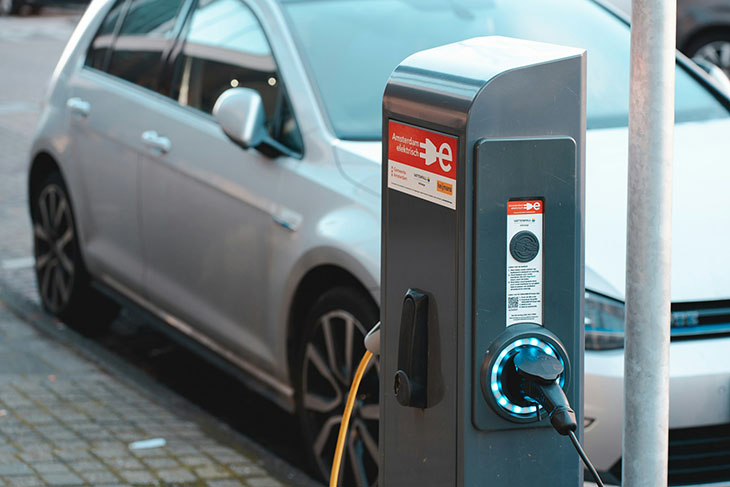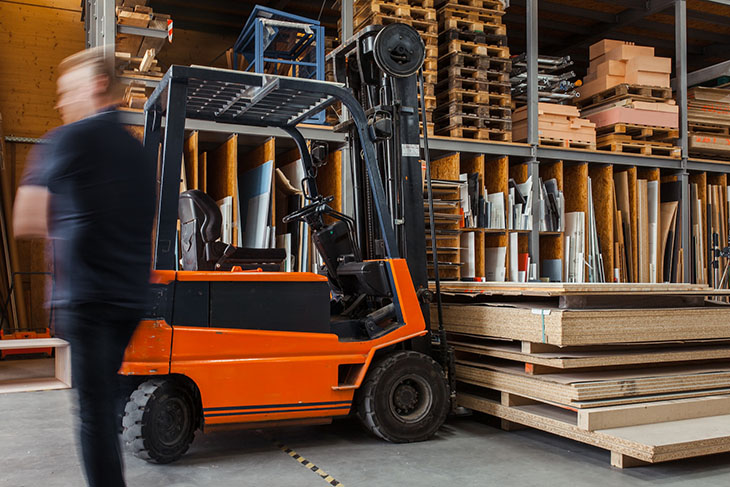
Reuse of the old shaft requires the special expertise of industrial fan manufacturer TLT-Turbo
In Duisburg, thyssenkrupp Steel Europe AG operates the largest steel production site in Europe. After a process adjustment to reduce dust emissions, signs of wear were discovered in the rotor of the sinter exhaust fan of sinter belt III during a regular bi-annual facility check. In order to ensure the functionality of the unit, the rotor was briefly replaced with an available replacement rotor from the warehouse, which took five days with a team of 20 to install. Industrial fan expert TLT-Turbo GmbH was then commissioned to produce a new rotor. One of the challenges of this project was that the undamaged shaft still had to be retained, as well as the rotor constructed around it.
At the thyssenkrupp Steel Europe AG plant in Schwelgern, iron ore and other substances are processed into sinter and prepared for the production of pig iron. Over 30,000 t of sinter are produced on the three conveyor belts every day, which also creates dust. Multiple units are used to continuously filter this dust so as to prevent as many emissions as possible. To this end an electrical filtration unit was initially installed directly behind the sinter unit, which is followed by the sinter exhaust fans. In order to even further improve air pollution control, the company invested an additional 46 million euros in a modern tissue filter for sinter belt III, which was installed after the sinter exhaust fans. These are able to filter out 99.99 per cent of the dust.
“While installing this hose filtration unit onto belt III it was necessary that we curb the sinter unit’s output,” explains engineer Erwin Unger, product specialist in Aftermarket Service at TLT-Turbo GmbH and head of the project at thyssenkrupp Steel Europe. “The result was that the output of the sinter exhaust fan had to be reduced as well. This happens by closing the inlet vane control.” However, during this process the free spaces between the individual inlet vane control blades get smaller, while the gas speed increases. This results in the gas spinning faster than the rotor itself. The sinter dust then migrates from the top to the bottom of the rotor blades.
Routine check reveals signs of wear on the bottom of the rotor blades
In normal operation, the sinter dust only accumulates on the top of the rotor blades. Because these are coated with a special anti-wear substance, the dust is as good as harmless. The bottom, however, is made from uncoated, relatively soft steel. On the hardness scale developed by mineralogist Friedrich Mohs, sinter dust is in the same category as diamond. The material is one of the hardest substances in the world. This also explains the signs of wear on the rotor, which were discovered during a routine check of the fan of belt III despite the low quantity of approximately 50 mg/m3 of gas. “Some of the fastening screws for the wear protection were heavily eroded. And the round iron at the opening to the shovels showed massive signs of wear,” says the project head. The sinter dust also created holes in the middle plate of the rotor below the blades, approximately 300 mm long and about 30 to 40 mm wide.
Reconstruction of the rotor while retaining the shaft
In order for the sinter unit to be able to resume operations as quickly as possible, thyssenkrupp Steel Europe dismantled the rotor with help from installers from TLT-Turbo and replaced it with a substitute rotor from the warehouse that was readily available. The old rotor, produced in 1970 by TLT-Turbo GmbH’s predecessor company, Dinglerwerke AG, was burned off the hub after nearly 50 years of service at the thyssenkrupp factory. The shaft and hub were then shipped to Bad Hersfeld, where a rotor had to be newly constructed and produced based on the old rotor.
One particular challenge was that the shaft had to be retained. “The construction of a new shaft would have cost about 150,000 euros more. But this investment wasn’t necessary because the old one was still completely intact,” says Unger. But this posed other unique challenges for TLT-Turbo. Firstly, the new rotor had to be suited to the old shaft, which is not a standard process for the internationally active experts in industrial fans. Secondly, 47-year-old rotor also exhibited a rather complex structure, the reproduction of which required considerable expertise and experience.
On-time delivery of the new replacement rotor for the warehouse
“Our team of engineers tailored the new rotor to the current standards. The shaft was also adjusted for further use and then combined with the rotor. In order to optimally protect the rotor against sinter dust, it was given long-lasting anti-wear protection that has to be replaced only every ten years. “The work on the rotor was particularly challenging for our new balancing bench, because the rotor puts about 35 t on the scale,” reports Unger. Despite the great challenges, the rotor was constructed, finished and delivered on time, and is now being stored in a thyssenkrupp Steel Europe warehouse so that they can react quickly to similar incidents and replace the damaged rotor.
The installation of the replacement rotor stored in the warehouse, which took a team of 20 from TLT-Turbo to complete, also required extensive planning. “Despite the size of the warehouse, the space is used really effectively, so the installation of the new rotor demanded good preparation. That means, we had to devise a plan in advance which parts would be dropped off where, so that everything could proceed smoothly and without any major loss of time,” explains Unger. Dismantling of the replacement rotor and commissioning of the new rotor was estimated to take four to five days in total. The workers from TLT-Turbo worked around the clock with 10-man shifts to meet this deadline. “Our team is very experienced and often finishes their work hours before the predicted time of completion. This time was no different,” says Unger. The unit could thus resume regular operations with the usual output on schedule. After the work was complete thyssenkrupp Steel Europe was very satisfied with the course of the project and the quality of the new rotor.
thyssenkrupp Steel Europe AG is based in Duisburg (North Rhine-Westphalia) and represents the steel division of the international parent corporation thyssenkrupp AG. Its core business areas include steel production and the manufacture of flat products made from quality steel. The company also provides various services related to steel, and works with clients to develop products for a variety of industries: automotive, machinery and special vehicle construction, household appliances, packaging, the energy sector and the construction industry. Approximately 12,000 t of raw steel are produced for this purpose every year, making thyssenkrupp Steel Europe the largest producer of flat steel in Germany. The company has five locations in Duisburg and employs more than 27,500 workers.
TLT-Turbo GmbH is one of the world’s leading producers of technology-oriented, industrial fans and air technology systems. The company traces its history back to Dinglerwerke AG, founded in 1827, and was acquired by POWERCHINA in February 2014. Along with its German locations in Zweibrücken, Oberhausen, Frankenthal and Bad Hersfeld, TLT also operates companies, branches and offices in China, Austria, Russia, the USA, Korea, South Africa, South America, India and Hungary. The company’s radial and axial fans, wind tunnel fans and tunnel ventilation systems are used in thermal power plants around the world, in mine ventilation, steel production and processing, the (petro-)chemical industry, cement production, waste incineration, tunnel ventilation, wind tunnels and at testing facilities. The TLT-Turbo Group currently employs around 500 workers, some 390 of whom are in Germany.
More info:
TLT-Turbo GmbH
Gleiwitzstraße 7, 66482 Zweibrücken, Germany
Tel.: +49 6332 808-0, Fax: +49 6332 808-267
E-mail: This email address is being protected from spambots. You need JavaScript enabled to view it.
Internet: www.tlt-turbo.com
























